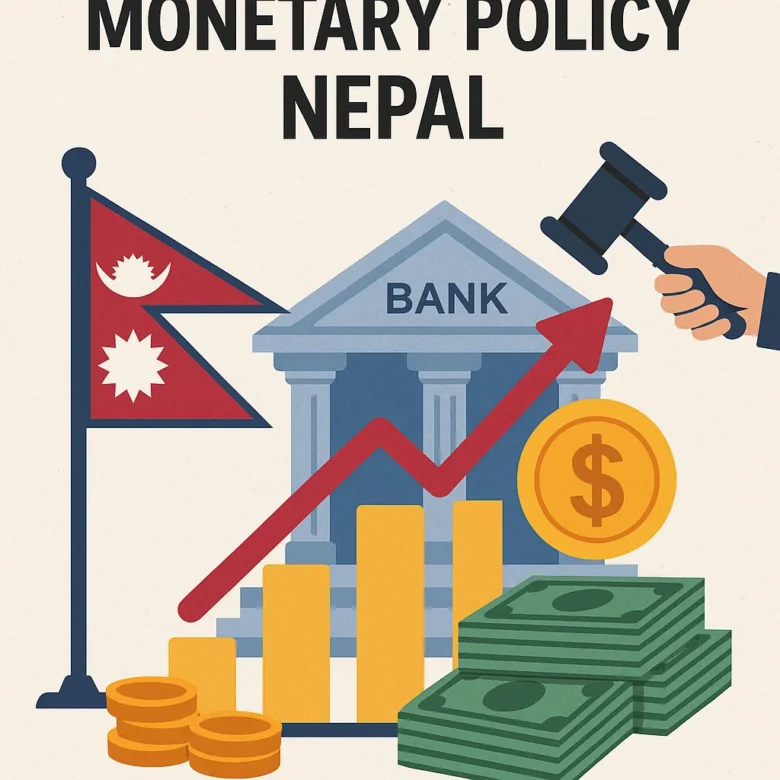“Nepal Rastra Bank (NRB) has unveiled its revised monetary policy for FY 2082/83, targeting inflation control and economic growth. Key measures include adjusted interest rates to balance savings and credit flow, with inflation capped at 6.5%. Priority sectors like agriculture and SMEs will receive focused lending support. The policy also promotes digital finance to enhance accessibility. Amid global uncertainties, the NRB aims to stabilize the financial sector while boosting domestic productivity. Liquidity management and fintech innovation remain central to this strategy. These revisions align with Nepal’s broader economic recovery goals. Read more for a detailed breakdown of the policy’s implications.”
1. Cheaper Money for Banks
What changed?
- Policy rate cut from 5 % to 4.5 %
- Bank rate cut from 6.5 % to 6 %
- Deposit collection rate cut from 3 % to 2.75 %
Why it matters:
These are the rates at which commercial banks borrow emergency funds from NRB or park excess cash. Lower rates mean banks can now obtain or roll over short-term money more cheaply. In theory, that should trickle down to lower lending rates for households and businesses—but only if banks pass the saving on.
2. A Clear Credit Target
What changed?
- NRB has formally targeted 12 % growth in private-sector credit for FY 2082/83.
Why it matters:
Nepal’s economy has been running on sub-10 % credit growth for two straight years. A 12 % target is a signal to banks: “Lend more, but lend well.” Whether banks hit the number will depend on both demand (are firms willing to borrow?) and risk appetite (are banks willing to lend beyond blue-chips?).
3. Housing Loan Gets a Double Boost
What changed?
- Ceiling for residential loans raised from NPR 20 million to NPR 30 million.
- Loan-to-Value (LTV) ratio raised to 80 % for first-time buyers (70 % for second homes).
Why it matters:
Urban real-estate prices have outpaced wage growth, pushing the average Kathmandu apartment beyond the old 20 million cap. Raising the ceiling and the LTV lowers the entry barrier for middle-income families and revives construction-linked jobs—but also increases systemic risk if prices correct.
4. Margin-Loan Headroom for Equity Investors
What changed?
- Personal margin-loan limit up from NPR 15 million to NPR 25 million.
- Valuation collar set at 70 % of the 180-day average price.
Why it matters:
Nepal’s stock market has been range-bound since the 2021 bull-run crash. By letting investors borrow more against existing shares, NRB hopes to inject liquidity and restore confidence. Critics warn it could fuel speculative bubbles if the underlying earnings do not improve.
5. Travel & FX Tweaks
What changed?
- Outbound travel allowance (outside India) raised from USD 2,500 to USD 3,000 per trip.
- Bangladeshi Taka and Sri-Lankan Rupee added to the list of convertible currencies.
Why it matters:
Inflation in global airfare and hotel prices had eroded the real value of the old USD 2,500 cap. The extra USD 500 eases family travel budgets and supports tourism-related service exports when Nepalis spend abroad.
6. Faster Doors for Foreign Money
What changed?
- Repatriation rules—covering capital, profit, and dividends—streamlined under a revised regulation.
- Non-Deliverable Forward (NDF) exposure limit for banks lifted from 20 % to 25 % of core capital.
Why it matters:
Foreign investors have long complained about slow or opaque exit processes. Simplifying repatriation lowers perceived country-risk, while a higher NDF limit lets banks offer better FX hedging products—both key to wooing FDI in hydropower, IT, and manufacturing.
7. What Did Not Change
- Cash Reserve Ratio (CRR) stays at 4 %.
- Statutory Liquidity Ratio (SLR) stays at 8 %.
- Forex-reserve target remains ≥ 7 months of import cover.
These unchanged buffers signal that NRB is willing to stimulate credit, but not at the cost of external-sector stability.
Bottom Line
The 2082/83 monetary policy is best described as “cautiously accommodative.” It gives banks cheaper liquidity, homebuyers and investors bigger borrowing levers, and foreign investors clearer exit paths. The success test will be transmission: whether banks actually cut lending rates and whether credit picks up in productive sectors rather than just real-estate and equities.
For households, the housing-loan relief could arrive within weeks; for the broader economy, the 12 % credit-growth gamble will play out over the next twelve months.




Leave a Reply